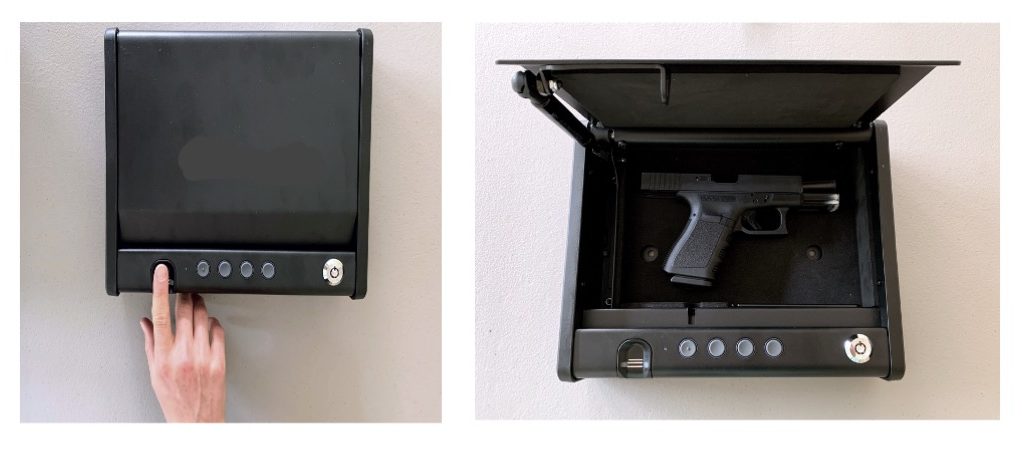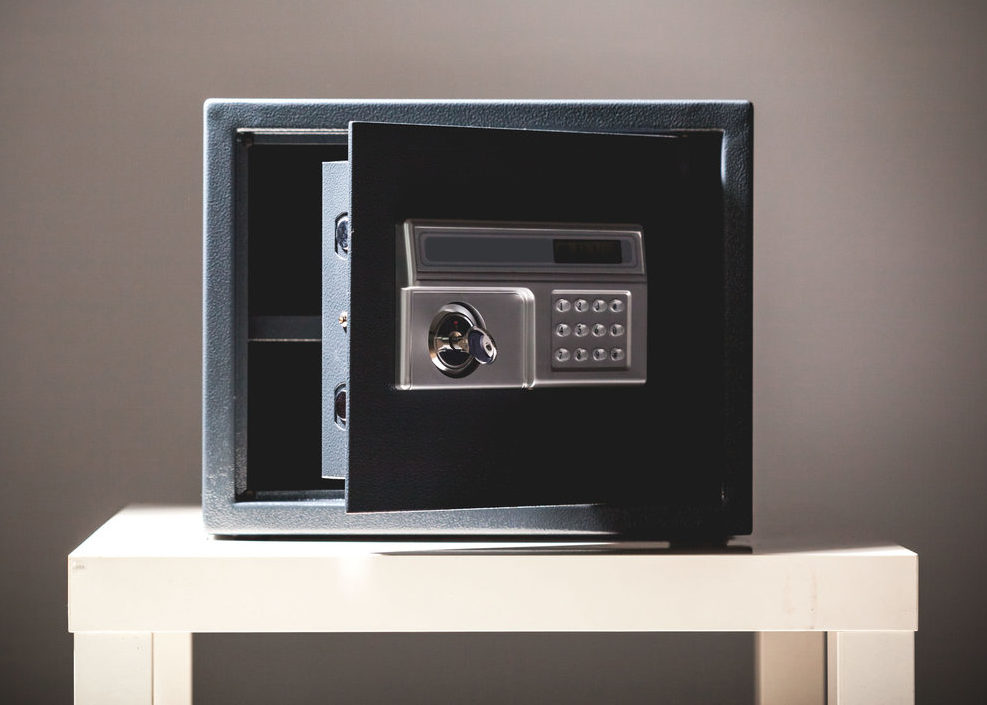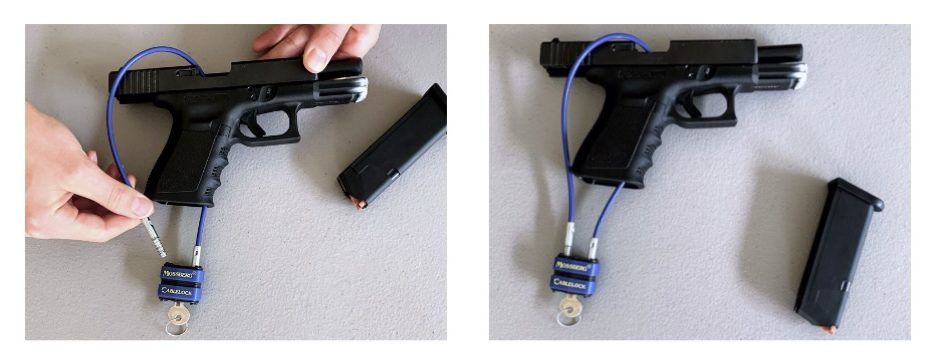Safe Storage
If guns are kept in the home, storing them safely can prevent firearm injury
Guns that are not stored safely increase risk of suicide, homicide, and unintentional injury for household members.
There are firearms in one-quarter of households in California and approximately one-third of households nationwide.1,2 Unsafe storage of guns increases the risk of firearm injury in the home.3-5 If a patient has firearms in the home and no one is at immediate risk of harm, clinicians should open a conversation about the importance of safe storage and the available options. Individualized conversations with patients can help providers make realistic and acceptable recommendations. The most appropriate storage device will vary depending on the patient.
If someone is at immediate risk, other interventions might be necessary to reduce harm.
Risks of Unsafe Firearm Storage
Not storing firearms safely may result in access by unauthorized household members, which can lead to firearm injury or death. For example, unsafe storage and storage that allows children and teens access to firearms are associated with higher risk for firearm suicide and unintentional firearm injuries and may be a key factor in school shootings.3-6
Many parents assume children are unaware of firearms in the home, but research has shown that children often know where guns are kept, and have handled them without their parent’s knowledge. One study, which separately surveyed children and parents, found that two-fifths of parents incorrectly believed that their child didn’t know where the gun was kept, and one-fifth incorrectly believed that the child had never handled the weapon without their consent.7
How to Safely Store Guns
Despite the increased risk when firearms aren’t stored safely, fewer than half of owners nationwide, and only 35% of owners in California, store all firearms in the most safe manner.8,9 Statistical modeling shows that 150 firearm deaths from suicide and unintentional injury could be prevented each year if only 30% more families stored their guns safely.10 Clinicians should be aware of the various safe storage devices to make informed recommendations to patients. Research suggests that parents are more likely to use safe storage practices when a storage device is provided to them during a doctor’s visit.11
The safest way to store a gun is:
- Unloaded
- Locked up using a locking device, like a lock box or a gun safe
- Separate from ammunition
- With the keys and combinations to firearm locking devices inaccessible to children, unauthorized users, and others at risk
The most appropriate locking device may depend on the type of firearm to be secured, as well as the patient’s intended use.
What You Can Do
Clinicians should talk through safe storage options with patients to find the device(s) that will work best, considering the patient’s preferences and needs as well as the degree of risk at home. Clinicians should also urge parents and caregivers to assume that children know where firearms and ammunition are kept in the home, and maintain the habit of storing firearms safely at all times.
Safe storage devices can be purchased from gun retailers and sporting goods stores (including online) and are sometimes available free from local law enforcement. In California, all firearms are sold with a safe storage device, unless the buyer proves that he or she already owns a state-approved firearm safe.
Many firearm owners take safe storage very seriously and consider it a key tenet of firearm ownership.
The four examples below are the most common types of safe storage devices for semi-automatic pistols, a typical handgun.
Storage devices for other types of firearms, such as rifles or shotguns, look slightly different but generally function in the same way.
Lock Boxes
Lock boxes secure guns through a variety of mechanisms, including keys, combinations, or biometric technology, which open using fingerprint recognition. Many types of lock boxes allow quick access to firearms, making them a preferred safe storage method for those who own guns for protection and want to store them safely while keeping them quickly accessible.

In addition to making guns inaccessible to children and other unauthorized users, lock boxes keep firearms out of sight. Some lock boxes also include cables or other features to deter theft by allowing users to secure them to a fixed post. Ideally, firearms stored in lockboxes should be stored unloaded, and ammunition should be locked up elsewhere.
Gun Safes
Gun safes can accommodate multiple firearms of different sizes. They use one of a variety of locking technologies, including combinations, keys, and biometric technology. Ideally, firearms stored in safes should be stored unloaded, and ammunition should be locked up elsewhere.

Like lock boxes, gun safes also keep guns out of sight, and deter theft because they can be heavy and difficult to move. Gun safes are the most expensive safe storage option.
Cable Locks
A cable lock renders a firearm temporarily unusable by blocking it from being loaded or fired. A cable lock works by inserting a steel cable out the action of the firearm so the action cannot be closed. Then the cable is locked and the key removed.
A cable lock can be locked through the magazine well and out the action of the firearm, as shown in the photo below, or instead from the action through the barrel and out the muzzle of the gun. Both of these methods keep a gun’s action from closing.
Firearms must be unloaded to use a cable lock. Cable locks do not prevent theft or keep firearms out of sight. They may also be easily cut by a thief or determined user.

Cable locks are the least expensive locking device. They are given away for free by some gun retailers, hospitals, and law enforcement agencies.
Trigger Locks
A trigger lock has two pieces and blocks the trigger from being fired. It’s critical to make sure the gun is unloaded when using a trigger lock; putting the lock on a loaded gun could cause it to fire. Separate the lock into two pieces, then insert the post of the lock in front of the trigger and through the trigger guard so the trigger can’t be pulled. Then attach the other side and lock the device, and remove the key.

While trigger locks block the trigger, they do not prevent loading, and in rare circumstances, may allow the gun to fire even when in place. Additionally, locking a firearm with a trigger lock when the gun is loaded may result in accidental firing and serious harm. As with cable locks, trigger locks do not prevent theft, nor do they keep firearms out of sight.
Other Considerations
Concerns about home defense may affect the way a patient stores their firearms.8 In California, nearly half of firearm owners have guns primarily for protection against other people.9 These owners may desire an option that allows for both safe storage of a loaded weapon and quick accessibility, such as a biometric lockbox.
Many firearms have intrinsic safety devices, for example, the gun’s “safety.” Simply storing a firearm with the “safety on” does not adequately protect against unauthorized use. To store a firearm safely, a safe storage device such as those listed above should be used.
California has Child Access Protection (CAP) laws. Adults can be found guilty of a felony if a minor obtains a firearm from their property that was not stored safely and subsequently causes injury or death with it or carries it to a public place.12
- Firearm ownership and acquisition in California: Findings from the 2018 California Safety and Well-being Survey. Injury Prevention.
- Firearm Storage in Gun-Owning Households with Children: Results of a 2015 National Survey. Journal of Urban Health.
- Gun storage practices and risk of youth suicide and unintentional firearm injuries. JAMA.
- Access to firearms and risk for suicide in middle-aged and older adults. The American Journal of Geriatric Psychiatry.
- Who are the owners of firearms used in adolescent suicides?. Suicide and Life-Threatening Behavior.
- Most Guns Used in School Shootings Come From Home.
- Parental Misperceptions About Children and Firearms. Archives of Pediatric and Adolescent Medicine.
- Storage Practices of US Gun Owners in 2016. American Journal of Public Health.
- Firearm ownership in California: A latent class analysis. Injury Prevention.
- Association of Increased Safe Household Firearm Storage With Firearm Suicide and Unintentional Death Among US Youths. JAMA Pediatrics.
- Effectiveness of Interventions to Promote Safe Firearm Storage. Epidemiologic Reviews.
Learn more about potential interventions
Storing guns outside the home when someone is at risk can be lifesaving.
For more information, see these peer-reviewed articles.
Conner, A., Azrael, D., & Miller, M. (2020). Firearm Safety Discussions Between Clinicians and U.S. Adults Living in Households With Firearms: Results From a 2019 National Survey. Annals of Internal Medicine.
Monuteaux, M. C., Azrael, D., & Miller, M. (2019). Association of Increased Safe Household Firearm Storage With Firearm Suicide and Unintentional Death Among US Youths. JAMA Pediatrics.
Pallin, R., Spitzer, S. A., Ranney, M. L., et al. (2019). Preventing Firearm-Related Death and Injury. Annals of Internal Medicine.
Beidas, R. S., Jager-Hyman, S., Becker-Haimes, E. M., et al. (2019). Acceptability and Use of Evidence-Based Practices for Firearm Storage in Pediatric Primary Care. Academic Pediatrics.
Grossman, D. C., Mueller, B. A., Riedy, C., et al. (2005). Gun storage practices and risk of youth suicide and unintentional firearm injuries. JAMA.
Additional Resources on Safe Storage
Safe Firearm Storage: A Call for Research Informed by Firearm Stakeholders
A call to action for needed research informed by firearm stakeholders to help clinicians make acceptable, adoptable recommendations of ways to safely store firearms and reduce risk of injury and mortality.
Firearm Locking Devices
Educational brochure on locking devices that can keep personal firearms safe, secure, and ready.
End Family Fire
Resources and recommendations on how to prevent a family fire- a shooting involving an improperly stored or misused gun in the home that results in injury or death.
Lock to Live
An online decision aid to support healthcare providers counsel patients on how to identify and find safe options to store lethal means during times of crisis.
Own It? Respect It. Secure It.
Project ChildSafe is a program that promotes safety education and distribution of firearm safety kits across the US.
Be Smart
Resources and tools of the Be Smart campaign on safe storage practice, talking to children about guns, and other interactive resources.
Asking Saves Kids
Asking parents and guardians questions about the presence of a firearm in the home can save childrens' lives.
Safe Firearms Storage
The National Crime Prevention Council and the Advertising Council’s public education campaign encourages firearm owners to store firearms safely.
Patient Handout
A UC Davis resource from the What You Can Do Project that helps the general public assess firearm safety at home.